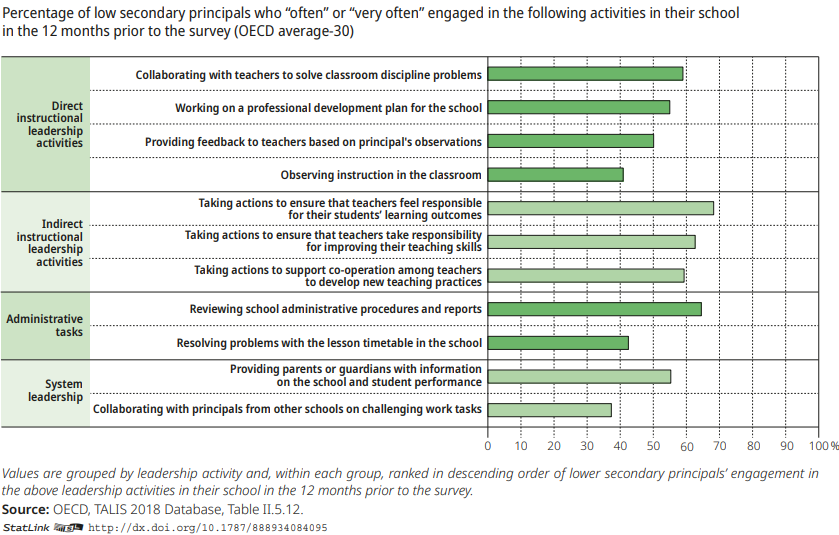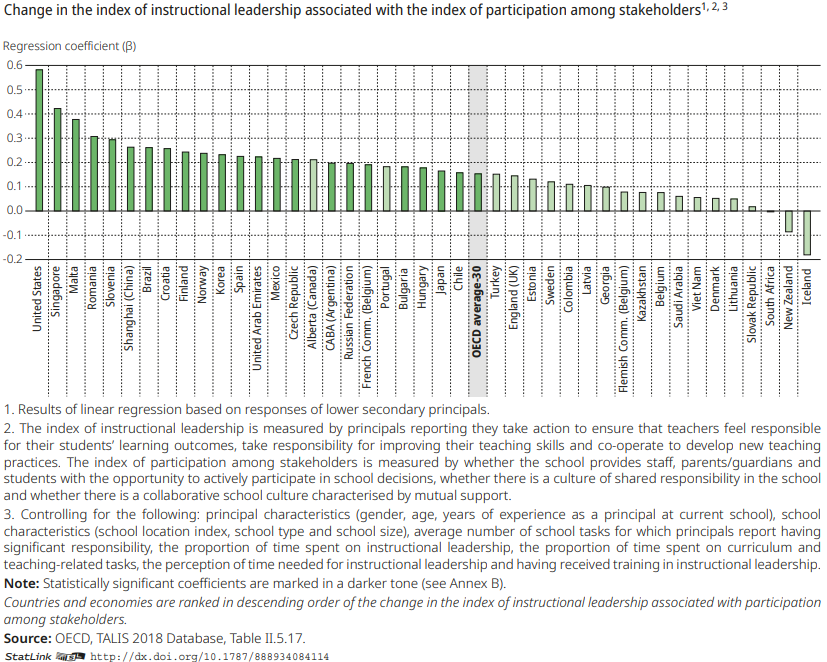School leaders grapple with the challenge of balancing organisational management and instructional leadership, often alongside teaching responsibilities. The effectiveness of school leadership varies with activity type; for instance, teacher coaching and programme development correlate with student achievement gains, whereas informal classroom walkthroughs do not, especially if disconnected from overall improvement strategies. Effective time management and prioritised activities are crucial for leaders. Training in these areas, supported by clearly defined leadership standards, could enhance their focus on essential tasks.
Instructional and administrative leadership
School leaders balance responsibilities for instructional leadership, which focuses on teaching and learning, and administrative leadership, concerned with the operational aspects of running an educational institution.

Key messages
Redistributing school management, evaluation and leadership tasks can enhance effectiveness by assigning specific roles for operations, administration or student behavior, thus alleviating the instructional leader's burden. Encouraging teachers to assume leadership roles leverages their expertise and offers professional development opportunities. Additionally, schools could benefit from appointing more leaders, allowing them to tailor responsibility division to their unique needs and staff capabilities.
Considering the importance of instructional leadership in supporting the professional growth of teachers, training in instructional leadership should be viewed as a prerequisite for school leaders prior to taking up their duties. Furthermore, the training of school leaders in this area should be seen as an ongoing process, with principals also offered opportunities for professional development in instructional leadership after taking up their duties in order to further develop these skills. School principals could be given opportunities to participate in communities of practice in order to improve their instructional leadership.
Context
Instructional leadership
On average across the OECD, a considerable proportion of principals are invested in direct forms of instructional leadership. For example, 59% of principals report that they “collaborated with teachers to solve classroom discipline problems” and 50% report that they “provided feedback to teachers based on [their] observations”.
Principals’ leadership activities (2018)

Instructional leadership and engaging stakeholders
Principals who are able to involve staff, parents and students in school decisions and have a school culture of collaboration and shared responsibility are more likely to report higher levels of instructional leadership. These results suggest interconnectedness between a collegial school culture and leadership committed to improving teacher instruction and commitment.
Relationship between principals’ instructional leadership and participation among stakeholders in the school (2018)

Related publications
-
 23 November 2018
23 November 2018
Programmes and projects
-
TALIS - the Teaching and Learning International Survey - is the world's largest international survey about teachers and school leaders.Learn more
-
PISA is the OECD's Programme for International Student Assessment. PISA measures 15-year-olds’ ability to use their reading, mathematics and science knowledge and skills to meet real-life challenges.Learn more
-
The Education Policy Outlook is an analytical observatory that monitors the evolution of policy priorities and policy developments from early childhood education to adult education, mainly among OECD education systems, to provide a comparative understanding of how policies are evolving, and how they can be best implemented or improved over time.Learn more
-
The OECD’s programme on education and skills policy support policymakers in their efforts to achieve high-quality lifelong learning, which in turn contributes to personal development, sustainable economic growth, and social cohesion.Learn more
-
Add a short description – maximum 200 characters (4 lines). This should outline the OECD’s mandate and the main issues/challenges with respect to the project. Writing style and tone should be clear, to the point, and jargon-free.Learn more
-
The OECD Indicators of Education Systems (INES) programme seeks to gauge the performance of national education systems through internationally comparable data.Learn more
-
The OECD’s expanding evidence base has highlighted the importance of high-quality teachers and teaching in education. Yet, challenging questions remain, and there is a need for space in the teacher debate to anticipate future developments, to strengthen professional identity and to support proactive teacher policy making.Learn more
-
Since 2013, the OECD has gathered evidence on how school resource policies work in different contexts. The focus is now on digital resources to enable countries to learn from each other in the digital transformation of their education.Learn more
-
Meeting the challenges of the 21st Century means that schools must be empowered to play a more central and active role in leading improvements in education. To support this, Schools+ will bring together major education networks to put schools at the centre of education design.Learn more
-
The Starting Strong Teaching and Learning International Survey (TALIS Starting Strong) is an international, large-scale survey of staff and leaders in early childhood education and care (ECEC).Learn more
-
Creativity and critical thinking prepare students for innovative economies and improve wellbeing. However, educators often lack guidance on how to equip students with creativity and critical thinking within subject teaching. Education systems have likewise rarely established ways to systematically assess students’ acquisition of creativity and critical thinking.Learn more



